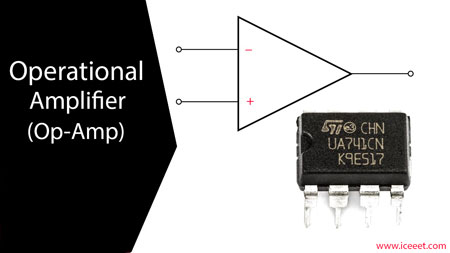Table of Contents
Operational Amplifier
Definition
An operational amplifier (OP-Amp) is an electronics circuit that can perform such mathematical operations as
addition, subtraction, integration, and differentiation.
Introduction
An Op-amp is basically a voltage amplifying device designed to be used with external feedback components such as resistors and capacitors between its output and input terminals. These feedback elements determine the resulting function or operation of the amplifier and by virtue of the different feedback configurations whether resistive, capacitive, or both, the amplifier can perform a variety of several operations, giving rise to its name of Operational Amplifier.
An OP-Amp is basically a three-terminal device that consists of two high impedance inputs. One of the inputs is called the Inverting Input, marked with a negative sign, ( – ), and the other input is called the Non-inverting Input, marked with a positive sign ( + ). A third terminal represents the operational amplifier’s output port.

Characteristics Of An Operational Amplifier
- An Op-Amp is a multistage amplifier. The input stage of an OP-amp is a
differential amplifier stage. - It has two Inverting input and noninverting input.
- Infinite input impedance.
- Zero output impedance.
- Very large CMRR(Common Mode Rejection Ratio).
- Infinite open-loop gain A.
- Infinite bandwidth.
- Infinite open-loop voltage gain.
- Zero noise contribution.
- Zero DC output offset.
- Differential inputs that stick together.
Pin Diagram of Operational Amplifier

Equivalent Circuit Of Operational Amplifier
 Operational Amplifier Practical Application
Operational Amplifier Practical Application
According to the definition, an Op-Amp can be used in many ways in practical life. the operational amplifier can be used as inverting amplifier, non-inverting amplifier, voltage follower, differentiator, integrator, summing amplifier, logarithmic amplifier, anti logarithmic amplifier, and voltage comparator, converter, etc.
Why Does An Op-Amp Have High CMRR?
A differential amplifier has high differential voltage gain (ADM) and very low common-mode voltage gain (ACM). The ratio ADM/ACM is called the common-mode rejection ratio (CMRR).CMRR is the ability of a DA to reject the common-mode signals. The larger the CMRR, the better theDA is at eliminating common-mode signals. The ability of the DA to reject common-mode signals is its main advantage. Common-mode signals are usually unwanted signals caused by external interference.
Frequency Response of an OP-Amp
The operating frequency has an important effect on the operation of an OP-amp. The following are the important points representing the frequency response of an OP-amp :
- The maximum operating frequency of an OP-amp is given by f max = Slew rate/2πVpk.
Thus, the max output voltage limits the maximum operating frequency. - When the maximum operating frequency of an OP-amp is gone beyond, the result is a
distorted output waveform. - Increasing the operating frequency of an OP-amp beyond a particular point will :
(a) Decrease the maximum output voltage swing.
(b) Decrease the open-loop voltage gain.
(c) Decrease the input impedance.
(d) Increase the output impedance.



1 comment
[…] electronic circuits. It has been very useful in reducing noise in amplifiers and making amplifier operation […]